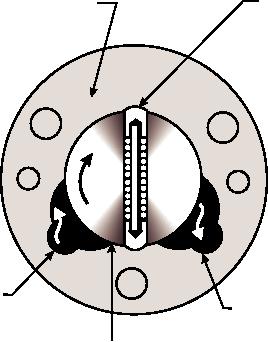
VA N E
ROTOR HOUSING
of fuel must be delivered to each cylinder for each
power stroke of the engine. Only in this way can the
engine operate at uniform speed with a uniform power
output. Smooth engine operation and an even
distribution of the load between the cylinders depend
upon the same volume of the fuel being admitted to a
particular cylinder each time it fires, and upon equal
volumes of fuel being delivered to all cylinders of the
engine.
Injection Control
A fuel system must also control the rate of
injection. The rate at which fuel is injected determines
the rate of combustion. The rate of injection at the start
INLET
should be low enough that excessive fuel does not
OUTLET
accumulate in the cylinder during the initial ignition
delay (before combustion begins). Injection should
ROTOR
ASf04036
proceed at such a rate that the rise in combustion
Figure 4-36.--Vanes and rotor in housing of a vane-type fuel
pressure is not too great, yet the rate of injection must
pump.
be such that fuel is introduced as rapidly as possible to
obtain complete combustion. An incorrect rate of
The remaining task to be accomplished by the fuel
injection affects engine operation in the same way as
system is to provide the proper quantity of fuel to the
improper timing. When the rate of injection is too high,
engine's cylinders. This is done differently by each
the results are similar to those caused by a too early
manufacturer and is referred to as fuel injection.
injection; when the rate is too low, the results are
FUEL INJECTION
similar to those caused by a too late injection.
Diesel fuel injection systems must accomplish five
Timing
particular functions: meter, inject, time, atomize, and
In addition to measuring the amount of fuel
create pressure. A description of these functions
injected, the system must properly time injection to
follows:
ensure efficient combustion so that maximum energy
METER. Accurately measures the amount of
can be obtained from the fuel. When the fuel is injected
fuel to be injected.
too early in the cycle, ignition may be delayed because
INJECT. Forces and distributes the fuel into the
the temperature of the air at this point is not high
enough. An excessive delay, on the other hand, gives
combustion chamber.
rough and noisy operation of the engine, and also
TIME. Injection of the fuel must start and stop
permits some fuel to be lost due to the wetting of the
at the proper time.
cylinder walls and piston head. This, in turn, results in
poor fuel economy, high exhaust gas temperature, and
ATOMIZE. Breaks the fuel up into fine
smoke in the exhaust. When fuel is injected too late in
particles.
the cycle, all the fuel will not be burned until the piston
CREATE PRESSURE. Creates the necessary
has traveled well past top center. When this happens,
high pressure for injection.
the engine does not develop its maximum power, the
exhaust is smoky, and the fuel consumption is high.
You can remember these functions by the initials
MITAC. All five of these functions are necessary for
Atomization of Fuel
complete and efficient combustion.
As used in connection with fuel injection,
Metering
atomization means the breaking up of the fuel, as it
enters the cylinder, into small particles that form a
Accurate metering or measuring of the fuel means
mist-like spray. Atomization of the fuel must meet the
that, for the same fuel control setting, the same quantity
4-29

